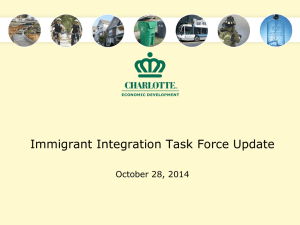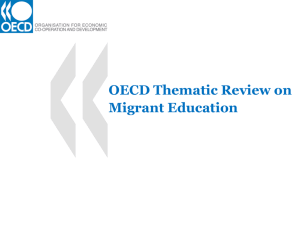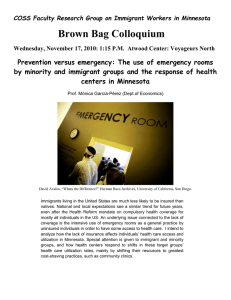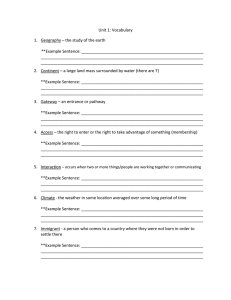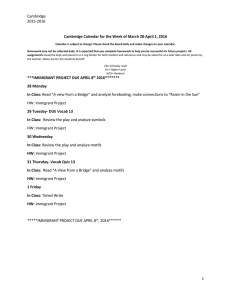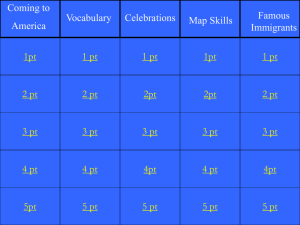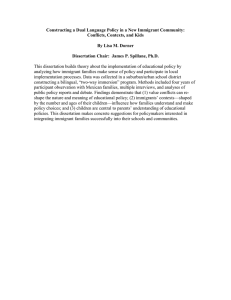National Immigrant Communities Project
advertisement
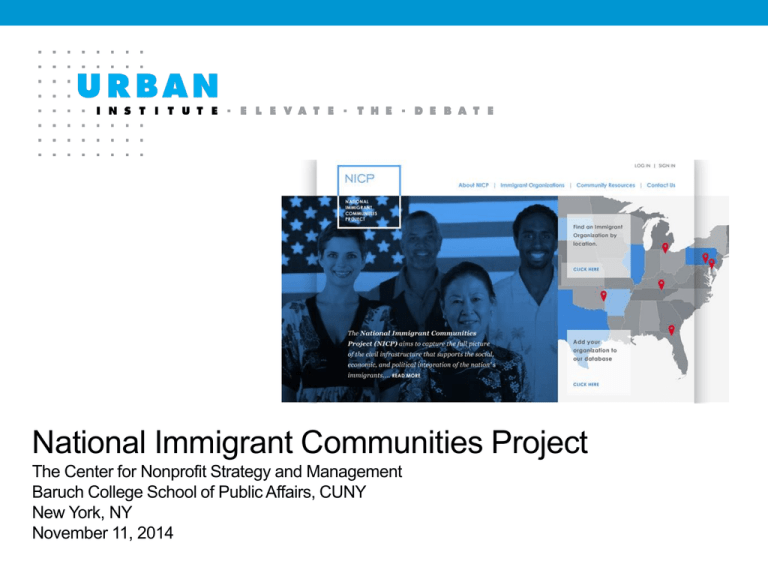
National Immigrant Communities Project The Center for Nonprofit Strategy and Management Baruch College School of Public Affairs, CUNY New York, NY November 11, 2014 National Immigrant Communities Project What is the National Immigrant Communities Project (NICP)? The need The three phases What is the current status of NICP? NCCS list of immigrant organizations Proof-of-concept beta website What are the challenges facing NICP? Identifying and classifying immigrant organizations Limitations of NCCS Funding How can you be part of NICP? The Need Immigrant organizations “play a central role during all parts of the immigration process and in the social, cultural, political, and economic” integration of immigrants (Cordero-Guzman 2005, 889). Immigration specialists, researchers, scholars, and advocates: voice the need for information on the capacity of immigrant organizations; and recommend that data should be collected, shared, and mapped according to the types and levels of service provided by different organizations (Riosmena 2013). Immigration initiatives and reaching immigrants. A full picture of the infrastructure supporting immigrant integration is called for. This includes immigrant organizations, community-based nonprofits, public agencies , businesses, public-private partnerships, private funders, and other community entities. The Need The Three Phases A joint project of Urban’s Center on Nonprofits and Philanthropy and Metropolitan Housing and Communities Policy Center Phase 1: Identify and map immigrant organizations in the U.S. Phase 2: Develop an interactive online platform and resource for key stakeholders: Immigrant communities and organizations Advocates, researchers, and other interested parties Government agencies and funders Phase 3: Survey organizations to gather detailed, systematic information on: Immigrant communities Immigrant organizations Immigrant integration Phase 1: Identifying & Mapping Organizations Immigrant organizations are those with a mission and/or activities that address the aspirations, issues and needs of people with similar national/ethnic origins and/or immigrant communities in general (adapted from Gleeson and Bloemraad 2012). These include: Congregations Human Services Arts and Culture Education Civil Rights/Advocacy Other Phase 1: Identifying & Mapping Organizations Identify immigrant organizations in the National Center for Charitable Statistics (NCCS) database NTEE code P84 (Ethnic and Immigrant Centers) List of countries of origin of foreign-born population List of identifiers by country (e.g., Philippine, Filipino, Pilipino) Focus on top ten countries of origin List identifiers by region/province (e.g., Kapampangan, Ilocano, Visayan) List other possible identifiers (e.g., Couples for Christ, Kababayan, Mutya) Classify by regions and sub-regions Africa (Sub-Saharan) Asia Central and South Asia, East Asia, Southeast Asia, Pacific Islands Mexico, Latin America, and the Caribbean Middle East and North Africa Europe Other (Canada, Australia, and New Zealand) Phases 2 & 3: Developing Platform & Surveying Organizations Phase 2: Develop an interactive online platform and resource for various stakeholders View maps of immigrant organizations and other immigrant-serving institutions and resources Upload organizational, institutional, and resource information Pull external data Search for organizations and other institutions Find community resources: Directories, calendars, libraries Phase 3: Survey organizations and gather information on: Immigrant communities Immigrant organizations and immigrant-serving institutions What is NICP? What is NICP? What is NICP? Project Status Identified 7,272 immigrant organizations: 4,874 classified African: 177 Asian and Pacific Islander: 2,525 Latino: 1,594 Middle Eastern and North African: 207 2,398 to be classified In NYS, 825 classified African: 27 Latino: 242 Asian and Pacific Islander: 325 TBD: 186 Concerns about gross undercounting and classification: For example, only 56 Filipino organizations nationwide are identified Continued cleaning and searching Proof-of-concept interactive website under development Ward 1, Washington, DC Project Status Immigrant Organizations in the U.S. Project Status Immigrant Organizations in NYS Project Status African Organizations Asian & Pacific Islander Organizations Latino Organizations Project Status Challenges & How You Can Help Limitations of keyword searches: Identifying organization names based on language/dialect, region, religion, etc. Extracting data using SQL Limited knowledge of racial/ethnic and immigrant communities Limitations of NCCS and similar databases: Immigrant organizations are often undercounted, precluded due to size and unincorporated status (Gleeson and Bloemraad 2012; Grønbjerg 2002; Toepler 2003). Limited project resources. An excellent solution: Join the project: Share lists Provide expertise and resources Collaborate in project development Get the word out National Immigrant Communities Project Salamat, gracias, thank you! For more information: Erwin de Leon (202) 261-5421 edeleon@urban.org
